Runo may refer to:
- Runo (legendary king), from The History of the Kings of Britain
- Ruño, an ethnic group of Peru
- Runö, an island in Estonia
- Cantos of the Kalevala
Runo may refer to:

Porvoo is a city and a municipality in the Uusimaa region of Finland, situated on the southern coast about 35 kilometres (22 mi) east of the city border of Helsinki and about 50 kilometres (30 mi) from the city centre. Porvoo was one of the six medieval towns of Finland, along with Turku, Ulvila, Rauma, Naantali and Vyborg. It is first mentioned as a city in texts from the 14th century. Porvoo is the seat of the Swedish-speaking Diocese of Borgå of the Evangelical Lutheran Church of Finland. Porvoo was briefly the capital of the former Eastern Uusimaa region.
Nordic folk music includes a number of traditions of Nordic countries, especially Scandinavian. The Nordic countries are Iceland, Norway, Sweden, Denmark and Finland.
Hiisi is a term in Finnic mythologies, originally denoting sacred localities and later on various types of mythological entities.

Runes are the letters in a set of related alphabets known as runic alphabets native to the Germanic peoples. Runes were used to write various Germanic languages before they adopted the Latin alphabet, and for specialised purposes thereafter. In addition to representing a sound value, runes can be used to represent the concepts after which they are named (ideographs). Scholars refer to instances of the latter as Begriffsrunen. The Scandinavian variants are also known as futhark or fuþark ; the Anglo-Saxon variant is futhorc or fuþorc.
Peredurus is a legendary king of the Britons in Geoffrey of Monmouth's pseudohistorical chronicle Historia Regum Britanniae. According to Geoffrey, he was the youngest son of King Morvidus and brother of Gorbonianus, Archgallo, Elidurus, and Ingenius.

Åkersberga is a locality and the seat of Österåker Municipality, Stockholm County, Sweden with 28,033 inhabitants in 2010.

Ruhnu is an Estonian island in the Gulf of Riga in the Baltic Sea. It is administratively part of Saare County but is geographically closer to the Latvian mainland. At 11.9 square kilometres (4.6 sq mi), it has currently fewer than 100, mostly ethnic Estonian, permanent inhabitants. Ruhnu Parish has the smallest population of Estonia's 79 municipalities. Before 1944, it was for centuries populated by ethnic Swedes and traditional Swedish law was used.

Proto-Norse was an Indo-European language spoken in Scandinavia that is thought to have evolved as a northern dialect of Proto-Germanic in the first centuries CE. It is the earliest stage of a characteristically North Germanic language, and the language attested in the oldest Scandinavian Elder Futhark inscriptions, spoken from around the 2nd to the 8th centuries CE. It evolved into the dialects of Old Norse at the beginning of the Viking Age around 800 CE, which later themselves evolved into the modern North Germanic languages.

The Björketorp Runestone in Blekinge, Sweden, is part of a grave field which includes menhirs, both solitary and forming stone circles.

Kihnu is an island in the Baltic Sea. With an area of 16.4 km2 (6.3 sq mi) it is the largest island in the Gulf of Riga and the seventh largest island of Estonia. The length of the island is 7 km (4.3 mi) and width 3.3 km (2.1 mi), the highest point is at 8.9 metres (29.2 ft) above sea level.
Julie Lemieux is a Canadian voice actress.

Piltene is a town in northwestern Latvia. The population in 2020 was 909.
This is a summary of the cantos of the Kalevala.

The Estonian Swedes, or Estonia-Swedes, or "Coastal Swedes" are a Swedish-speaking minority traditionally residing in the coastal areas and islands of what is now western and northern Estonia. The attested beginning of the continuous settlement of Estonian Swedes in these areas dates back to the 13th and 14th centuries, when their Swedish ancestors are believed to have arrived in Estonia from what is now Sweden and Finland. Almost all of Estonia's Swedish-speaking minority fled to Sweden during World War II, and only the descendants of a few individuals who stayed behind are permanent residents in Estonia today.

The Noleby Runestone, which is also known as the Fyrunga Runestone or Vg 63 for its Rundata catalog listing, is a runestone in Proto-Norse which is engraved with the Elder Futhark. It was discovered in 1894 at the farm of Stora Noleby in Västergötland, Sweden.

Gösta Otto Runö was a Swedish modern pentathlete who won a bronze medal at the 1920 Summer Olympics.

Estonian Swedish are the eastern varieties of Swedish that were spoken in the formerly Swedish-populated areas of Estonia on the islands of Ormsö (Vormsi), Ösel (Saaremaa), Dagö (Hiiumaa) and Runö (Ruhnu), and the peninsula of Nuckö (Noarootsi), by the local Estonian Swedes.
Scandinavian Academy of Aeronautics was a Swedish accredited college specializing in aerospace engineering and avionics, situated in Gothenburg from 1973 and in Karlsborg from 1998 to 2003. The college was a major contributor of engineers and researchers in partnership with the aerospace industry, major airliners and other universities.

The Walk Crisis was an episode in Estonia–Latvia relations over the territorial dispute along the border between the two countries, chiefly about the town of Walk and the island of Runö. The territorial dispute lasted from both countries' independence in 1918 until its settlement in a border agreement in October 1920.
Sven Rüno was a Swedish composer of film scores. He scored a number of the Åsa-Nisse comedy series. He also composed the 1938 Christmas song "Jul i främmande hamn".